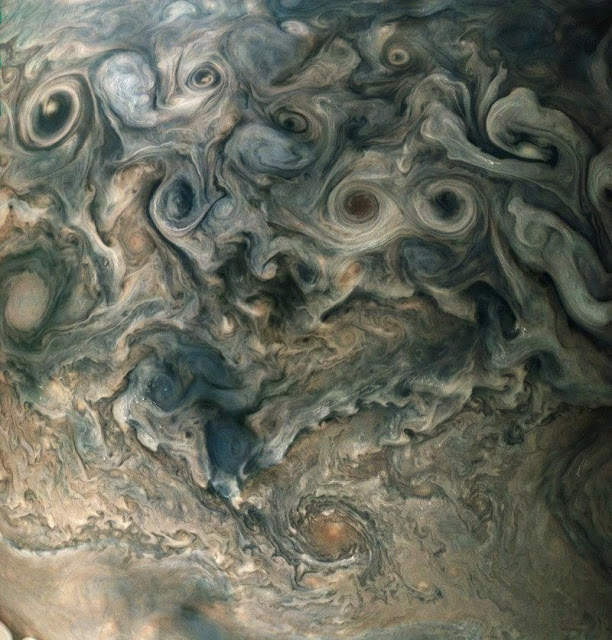Incredible new pictures show cyclones swirling above Jupiter’s poles
 |
A spectacular
image of Jupiter’s south pole seen from Juno more than 50,000 kilometres above
Credit: NASA/JPL-Caltech/SwRI/MSSS/Betsy
Asher Hall/Gervasio Robles.
|
These brand new amazing Jupiter pictures are aiding astronomers to turn theories about the planet upside down. Now mission scientists have published spectacular new images and more than forty new papers on the subject. Juno has showed us monstrous cyclones churning over Jupiter’s poles that are more turbulent than scientists expected. The $1.1 billion spacecraft Juno spotted the chaotic weather at the top and bottom of Jupiter once it began skimming the cloud tops last year, surprising researchers who assumed the giant gas planet would be relatively boring and uniform.
“What we’re finding is anything but that is the truth. It’s very different, very complex,” said Juno’s chief scientist Scott Bolton of the Southwest Research Institute.
The discovery of dozens of enormous cyclones hundreds of kilometres across mean that the poles look nothing like Jupiter’s equatorial region, a familiar view easily recognisable by its bands and the Great Red Spot.
“That’s the Jupiter we’ve all known and grown to love,” said Bolton. “And when you look from the pole, it looks totally different. I don’t think anybody would have guessed this is Jupiter.”
Citizen scientists processed the images to reveal the impressive level of detail that can be seen, although they do not give an accurate representation of what you would see with the naked eye from Juno’s position.
 |
Swirling
patterns above Jupiter’s north pole as captured by Juno
NASA/JPL-Caltech/SwRI/MSSS/Betsy
Asher Hall/Gervasio Robles.
|
The Juno spacecraft reached Jupiter beginning its first orbit on 4 July last year, traveling around the gas giant once every 53 days, with 33 planned pole-to-pole circuits in all, encircling the entire planet bit by bit.
Every one of these passes takes only two hours, with the journey consisting of a trip over the north pole, round the planet, over the south pole, and then back out into space. The next pass is to take place in July, then, the astronomers will set eyes on the Great Red Spot.
Apart from these polar cyclones, Juno has spotted white ice caps on Jupiter – frozen bits of ammonia and water. Juno has also detected an overwhelming abundance of ammonia deep down in the atmosphere, and a surprisingly strong magnetic field in places – roughly 10 times greater than Earth’s.
Juno’s findings are “really going to force us to rethink not only how Jupiter works,” said Bolton.
Journal reference: Science, DOI: 10.1126/science.aal2108
Journal reference: Science, DOI: 10.1126/science.aam5928
Journal reference: Geophysical Research Letters, DOI: 10.1002/2017GL074118
Sources: New Scientist, Southwest Research Institute, NASA









